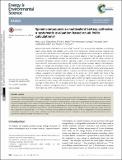Spinel compounds as multivalent battery cathodes: a systematic evaluation based on ab initio calculations
Author(s)
Liu, Miao; Rong, Ziqin; Malik, Rahul; Canepa, Pieremanuele; Jain, Anubhav; Ceder, Gerbrand; Persson, Kristin A.; ... Show more Show less
DownloadLiu-2015-Spinel compounds.pdf (1.072Mb)
PUBLISHER_CC
Publisher with Creative Commons License
Creative Commons Attribution
Terms of use
Metadata
Show full item recordAbstract
Batteries that shuttle multivalent ions such as Mg[superscript 2+] and Ca[superscript 2+] ions are promising candidates for achieving higher energy density than available with current Li-ion technology. Finding electrode materials that reversibly store and release these multivalent cations is considered a major challenge for enabling such multivalent battery technology. In this paper, we use recent advances in high-throughput first-principles calculations to systematically evaluate the performance of compounds with the spinel structure as multivalent intercalation cathode materials, spanning a matrix of five different intercalating ions and seven transition metal redox active cations. We estimate the insertion voltage, capacity, thermodynamic stability of charged and discharged states, as well as the intercalating ion mobility and use these properties to evaluate promising directions. Our calculations indicate that the Mn[subscript 2]O[subscript 4] spinel phase based on Mg and Ca are feasible cathode materials. In general, we find that multivalent cathodes exhibit lower voltages compared to Li cathodes; the voltages of Ca spinels are ~0.2 V higher than those of Mg compounds (versus their corresponding metals), and the voltages of Mg compounds are ~1.4 V higher than Zn compounds; consequently, Ca and Mg spinels exhibit the highest energy densities amongst all the multivalent cation species. The activation barrier for the Al[superscript 3+] ion migration in the Mn[subscript 2]O[subscript 4] spinel is very high (~1400 meV for Al[superscript 3+] in the dilute limit); thus, the use of an Al based Mn spinel intercalation cathode is unlikely. Amongst the choice of transition metals, Mn-based spinel structures rank highest when balancing all the considered properties.
Date issued
2014-12Department
Massachusetts Institute of Technology. Department of Materials Science and EngineeringJournal
Energy and Environmental Science
Publisher
Royal Society of Chemistry
Citation
Liu, Miao, Ziqin Rong, Rahul Malik, Pieremanuele Canepa, Anubhav Jain, Gerbrand Ceder, and Kristin A. Persson. “Spinel Compounds as Multivalent Battery Cathodes: a Systematic Evaluation Based on Ab Initio Calculations.” Energy Environ. Sci. 8, no. 3 (2015): 964–974. © 2015 Royal Society of Chemistry
Version: Final published version
ISSN
1754-5692
1754-5706